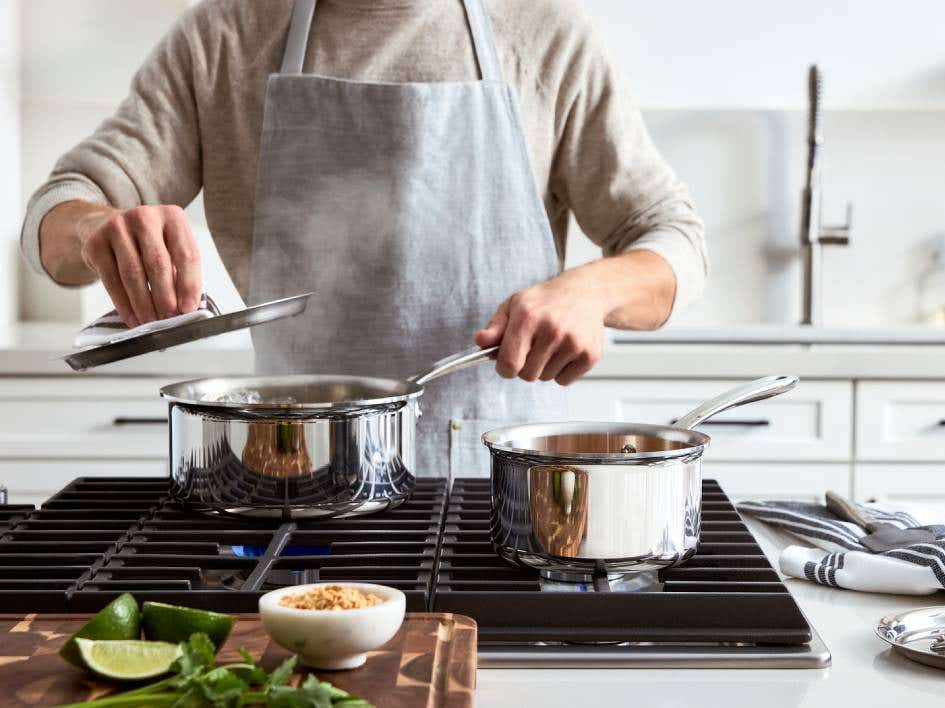
Rice is more than just a staple – it's the foundation of countless memorable meals. From weeknight dinners to elaborate celebrations, this versatile grain graces tables across the world, complementing everything from savory stews to stir-fries. Yet achieving that perfect pot of fluffy, tender rice can be surprisingly challenging. Master this essential cooking technique, and you'll unlock the secret to consistently delicious results that elevate any dish you create. Whether you're an experienced home cook or just starting your culinary journey, learning how to cook rice properly on the stove is a fundamental skill that will serve you well in countless recipes to come.
Perfect Rice-to-Water Ratio
Master fluffy rice with the right proportions in your All-Clad saucepan. For classic white rice, use 1½ cups water for each cup of rice. Basmati and jasmine varieties need slightly less liquid - about 1¼ cups water per cup of rice.
When cooking brown rice in your All-Clad pot, increase the water to 2 cups for each cup of rice, as these hearty grains require more moisture to achieve the perfect texture. For best results, bring your water to a boil first, then add the rice.
Remember that different rice varieties may need slight adjustments. Short-grain rice typically requires less water, while wild rice blends may need up to 2½ cups water per cup of rice.
For the most accurate results, always check your rice package for specific cooking instructions, as manufacturers often calibrate water-to-rice ratios for their particular grain variety and processing method. These guidelines serve as your starting point for perfectly cooked rice every time.
Essential Tools and Measurements to Cook Rice
Your All-Clad 3-quart saucepan with its tight-fitting lid creates the ideal environment for perfectly steamed rice. A fine mesh strainer helps remove excess starch before cooking, ensuring each grain remains distinct. Keep your All-Clad measuring cups handy - precise measurements make the difference between fluffy and mushy results.
For consistent outcomes, maintain a gentle simmer on low heat throughout cooking. Your All-Clad pot's superior heat distribution prevents hot spots that can lead to uneven cooking. After cooking, let your rice rest covered for a few minutes, allowing the steam to complete the cooking process naturally.
Step-by-Step Cooking Method
- Begin with a gentle rinse of your rice in cool water using your fine mesh strainer. Pour the measured rice and water into your All-Clad saucepan, bringing it to a rolling boil over medium-high heat.
- Once boiling, reduce heat to low and cover with the lid. Let your rice simmer undisturbed for 15 minutes - the superior heat distribution of your All-Clad pot ensures even cooking throughout.
- Remove from heat while keeping the lid on, allowing the rice to steam for an additional 10 minutes. This resting period is crucial for achieving that perfect, fluffy texture. Finally, lift the lid and gently fluff the rice with a fork, separating the grains for optimal serving presentation.
Timing Your Rice for Best Results: How long to cook rice on the stove?
White rice needs precise timing in your All-Clad saucepan for the best results. Set your timer for 15-18 minutes of gentle simmering, watching for small steam holes to appear on the surface. Monitor the heat carefully - you should see just a few bubbles breaking through occasionally.
Different varieties require adjusted cooking times. Long-grain white rice becomes perfectly tender in about 18 minutes, while medium-grain varieties need closer to 15 minutes. The preferred method for checking doneness is to tilt your pan slightly - properly cooked rice shows no excess water pooling at the bottom.
Remember that the 10-minute resting period after cooking is just as crucial as the active cooking time. This final steam ensures each grain reaches its ideal texture without becoming mushy.
Troubleshooting Common Rice Issues
- Add 1/4 cup hot water to rescue undercooked rice in your All-Clad pot, cover and steam for 5 minutes.
- Spread overly wet rice in a thin layer across your All-Clad pan, heat on low to evaporate moisture.
- Prevent sticking by coating your All-Clad pan bottom with a thin film of oil before adding rice.
- Fix burnt bottom by transferring unburned rice to a new All-Clad pot, adding small amounts of water as needed.
- Remove lumps by breaking apart cooled rice with moistened fingers or a fork sprayed with water.
- Salvage salty rice by mixing in unseasoned rice cooked separately in your All-Clad steamer basket.







